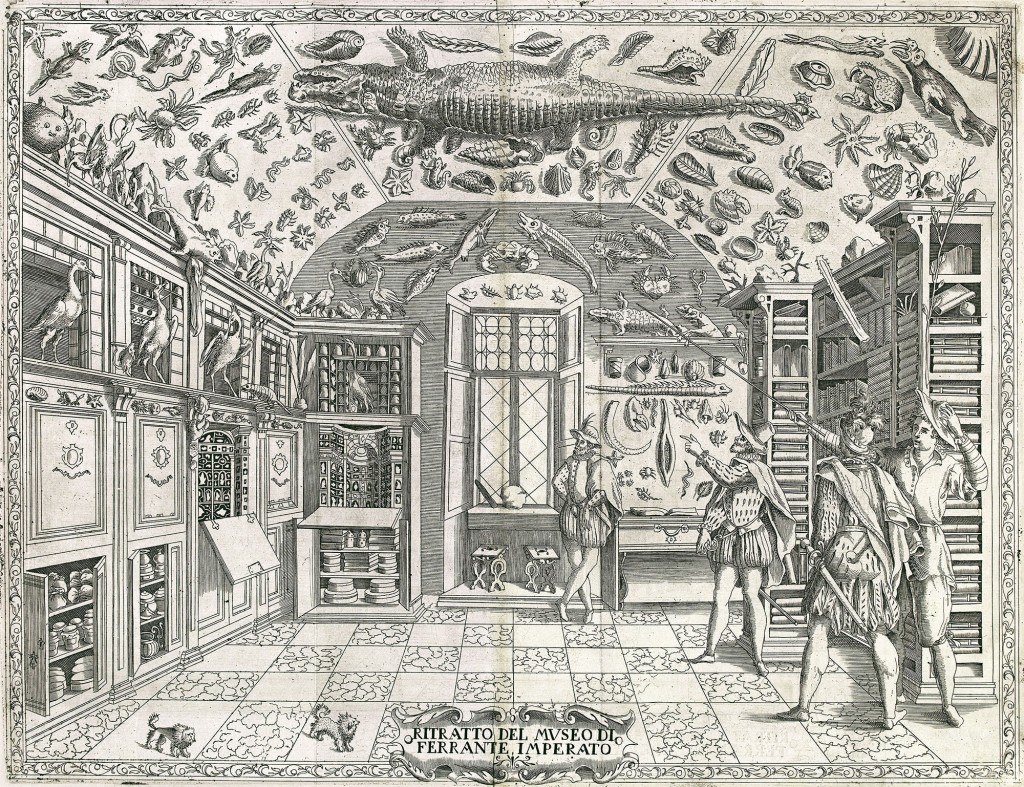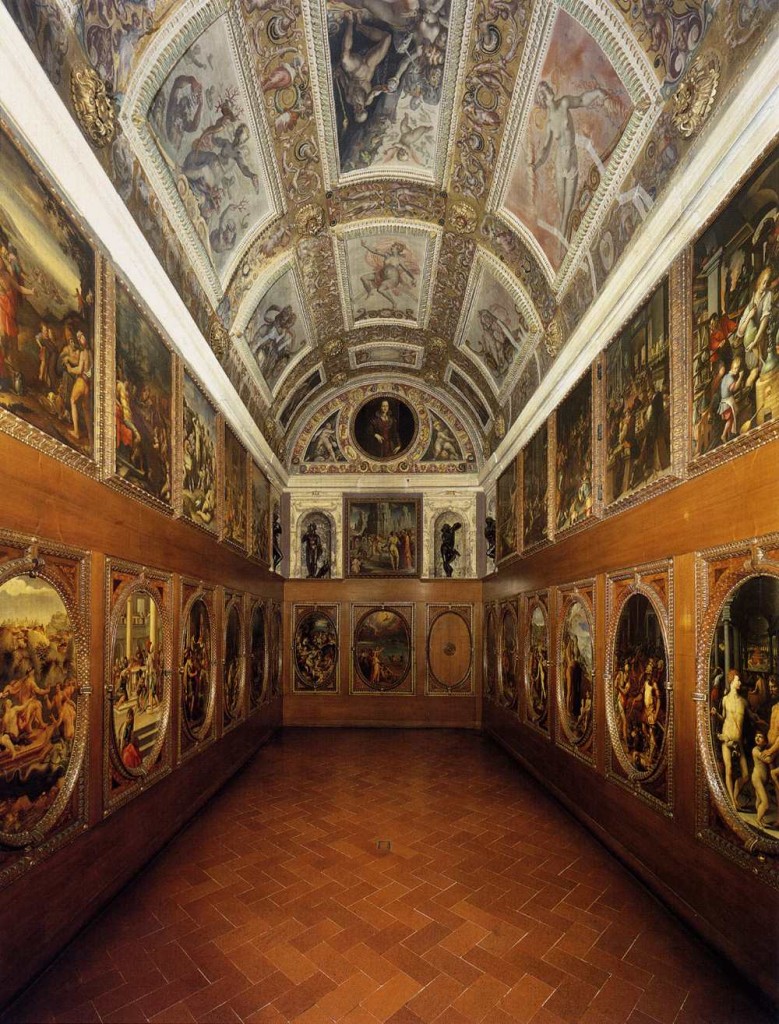Galileo’s Library 2.0: The Studiolo and Wunderkammer as Databases?
One of Galileo’s better known comparisons of Torquato Tasso’s Gerusalemme liberata and Ludovico Ariosto’s Orlando furioso involves representing each poem as a gallery.1 In disparaging tones Galileo compares reading Tasso’s poem to perusing a cluttered and immature study, a wunderkammer of bizarre pieces that lack the individual cohesion to suggest a coherent collection: “When I turn to consider the knights with their actions and adventures, as with all of the other little episodes of this [Tasso’s] poem, it seems like entering into the studietto of some curious little man, who delights in adorning it with things that have, either for antiquity, for rarity, or otherwise, something exotic about them, but which are in effect little things, having there, as one would say, a petrified crab, a dried chameleon, a fly and a frog encased in a piece of amber, some of those little earthen figures that they say are found in the ancient tombs of Egypt, and likewise, in the matter of painting, some little sketch by Baccio Bandinelli, or by Parmigianino, and countless other trifles.”2

Purportedly the earliest image of a natural history cabinet of curiosities, or wunderkammer. From Ferrante Imperato, Historia Naturale (Naples, 1599).
By contrast, Galileo goes on, reading Ariosto’s poem is similar to touring a well-organized Renaissance gallery filled with examples of the refined objects of classical and contemporary culture: “when I enter into the Furioso, I see opening up a wardrobe, a tribune, a regal gallery, ornamented with a hundred ancient statues by the most celebrated sculptors, with an infinite number of narrative pictures, and the best, by illustrious painters, along with a great number of vases – of crystals, of agates, of lapis lazuli and of other gems; and full of rare, precious, and marvelous things, and all of supreme excellence.”3

A 20th-century partial reconstruction of Francesco I de’ Medici’s study, or studiolo, a space for contemplation, study, and curiosity. Designed by Giorgio Vasari and collaborators on the Palazzo Vecchio, 1570-72.
Galileo’s seventeenth-century aesthetic offers a way to explore the tensions among sources of this comprehensive, elite intellectual tradition, its representations of reality, and the ways in which such an understanding of truth and the creation or discovery of knowledge can be modeled. Galileo was also acutely aware of the tension between the dizzying cohesion of the voices of this tradition and the ways in which they threaten to destabilize any truth claims offered about the poem or the society in which it was written, which gives him a means to articulate his own position within the philosophical tradition. His identification of the different mechanisms for making meaning in a literary text is also a rich metaphor for exploring how digital technologies might be designed to facilitate a comparison of these processes. Both the studiolo and the wunderkammer were sites of knowledge production during Galileo’s lifetime. His library is a partial representation of available data for creating that knowledge, for comparing Liu’s modeling regimes: the network and the patchwork.4 How do the texts operate in a studiolo (network) model? How do they operate in a wunderkammer (patchwork) model? How does a 21st-century user need to interact with a database to better understand either one?
There are two ways of adopting this studiolo imagery to explore the creation of meaning in Ariosto’s poem (a temporary synechdoche for the library as a whole): as a collection unto itself and as a discursive space for the generation of knowledge. Ariosto’s collection of collections, that is, the proliferation of castles and palaces that are adorned with the finest examples of pietre dure, mosaics, sculptures, gems, and precious metals, generate a textual space that mirrors the nascent princely collections of the early Cinquecento. (Digital clustering methods for text analysis seem to operate in a similar way by focusing on common features between texts.) The new, innovative, and anomalous items that make their way into the poem are typically located at the edges of Ariosto’s narrative map. The move between multiple canonical points of view to anomalous representatives of the breadth of human experience (such as giants, Cyclops, and dwarfs) is both a logical and a jarring outcome of the process, which may explain why Ariosto relegates most of his anomalies to the geographical and narrative margins of the poem’s spaces. Maraviglia is unproblematically a part of the characters’ experiences at the edges of the world.
Confusion instead results from the combination of recognizable conceits, tropes, and plots from canonical literary sources. The Furioso thrives on the assembly, or rather the re-assembly, of poetic texts that span literary history. They fill Galileo’s imaginary gallery of the poem. Yet, as they are placed in such textual proximity to one another, their accretion creates confusion within the text and without. (It is difficult not to draw parallels here with the mixed reaction to the values of “stop” words in authorship attribution rather than vocabulary, or the surprise at the unexpected similarities between disparate texts that large scale computational analysis has suggested.) The pieces themselves do not fail at cohesion, but diegetically they fail to produce the coherent narrative that the skilled reader knows and anticipates. In this way, the Furioso as a collection becomes a discursive space for literary tradition (represented by the statues and pictures in Galileo’s conceptualization of the poem) to engage questions of establishing accurate narratives to explain the world they encounter. Much of the poem functions on equivocation, willful or accidental, built upon literary tradition. The attentive reader can find this formula repeating many times in the Furioso. One example of the entrelacement in the Furioso will have to suffice here. When Rinaldo intervenes to stop the unintentional fratricide of Lurcanio and Ariodante as they defend Ginevra’s honor, the characters themselves are trapped in these pre-existing narrative structures. Ginevra is unwittingly employed in Polinesso’s staging of Guinevere and Lancelot; Ariodante follows Johanot Martorell’s Tirant lo blanco; Rinaldo, while at the monastery before learning of the story, heeds advice taken from Federico Fregoso in Castiglione’s Book of the Courtier. Together, these narrative lines could provoke the unnecessary demise of all parties involved.
There is a fine line between the incorporation of multiple sources into a single scene and the recognition that such a collection of perspectives has the innate power to destabilize any kind of universal claim to truth. (Perhaps practitioners of TEI markup, a method that can involve intimate understanding of a text when applied to its content, can also attest to this feeling?) As one scholar recently stated: “there’s more in this text than you can ever hope to control, comprehend, or keep straight; wisdom lies in accepting your limitations… as madness lies in seeking to exceed them.”5 Galileo had certainly learned this lesson. He concludes his parable of the new philosophy, a short story about the search for sounds, with the denial of universal comprehension. Galileo describes his protagonist after he kills the object of his investigation: “by this experience his knowledge was reduced to diffidence, so that when asked how sounds were created be used to answer tolerantly that although he knew a few ways, he was sure that many more existed which were not only unknown but unimaginable.”6
Although there are arguments to be made about the possible discontinuity between early sixteenth- and early seventeenth-century thought, the fact remains that the humbling confusion of the Furioso would not have been possible without the direct confrontation of the marvelous with the classical and medieval narratives woven into the poem. Similarly, the Copernican scholar would not have been able to propose a new narrative for observed phenomena without first examining the differing voices in the Renaissance gallery of cultural tradition. Galileo’s conception of the poem as a space for sight, narration, and confrontation, while elegant, nonetheless indicates the shift from seeing a collection as a space of unquestioned knowledge to using that gallery to generate the previously unimaginable, a sentiment with which centuries of delighted (if not frustrated) readers of the Orlando furioso would likely agree.
Yet, the model that Galileo so disparages in a literary context, the cabinet of curiosities, the wunderkammer, became a standard representation of natural philosophy in the seventeenth century. The database that Liu imagines seems modeled after such a collection. Julia Flanders expands eloquently on Liu’s patchwork model, which I take here to also be the wunderkammer model for Galileo’s time: “A patchwork or mosaic, on the other hand, connects pre-existing informational nodes while acknowledging them to be incommensurable: taken from different semantic spaces, from different contexts of purposiveness and original utility, not automatically the right size and shape.”7 I would argue that it is not by coincidence that Galileo’s criticisms of Tasso’s poem adopt the metaphor of mosaics and intarsiatura (inlaid wood).
What would it mean to put these concepts into practice? What are the network techniques of digital humanists? Could possible answers be XML through the Text Encoding Initiative, part-of-speech (POS) tagging, key words in context (KWIC), named entity recognition, and the search for quotations and allusions? What then are the patchwork techniques? Ngram comparisons, linguistic entropy measures, search (without context), certain methods for topic modeling? What would be the parallel actions in the early modern context of natural philosophy? Rather than design a database that reflects either one approach or the other, a better understanding of Galileo can only occur through a comparison of the two – being able to move between the results of one philosophy of knowledge to the other. A dear colleague in Computer Science has suggested to me that this problem is worthy of an NSF grant proposal, but in the meantime there is much data to gather and clean.
[1] See Le opere di Galileo Galilei. Edizione nazionale sotto gli auspici di Sua Maestà il Re d’Italia, ed. Antonio Favaro and Isidoro del Lungo (Florence: G. Barbèra, 1890-1909; reprinted 1929-39, 1963-66) vol. IX, 69. All translations are the author’s unless otherwise noted.
[2] Translation given in Jonathan Unglaub, Pouissin and the Poetics of Painting (Cambridge: Cambridge University Press, 2006), 117.
[3] Ibid, 117.
[4] Alan Liu, “Sidney’s Technology: A Critique by Technology of Literary History” in Local Transcendence: Essays on Postmodern Historicism and the Database (Chicago: University of Chicago Press, 2008), 187-206.
[5] Robert W. Hanning, Serious Play: Desire and Authority in the poetry of Ovid, Chaucer, and Ariosto (New York: Columbia University Press, 2010), 231.
[6] Galileo Galilei, Assayer, trans. Stillman Drake (Philadelphia: University of Pennsylvania Press, 1968), 258.
[7] Julia Flanders, “Rethinking Collections” in Advancing Digital Humanities. Research, Methods, Theories, eds. Paul Longley Arthur and Katherine Bode (London: Palgrave Macmillan, 2014), 163-174.